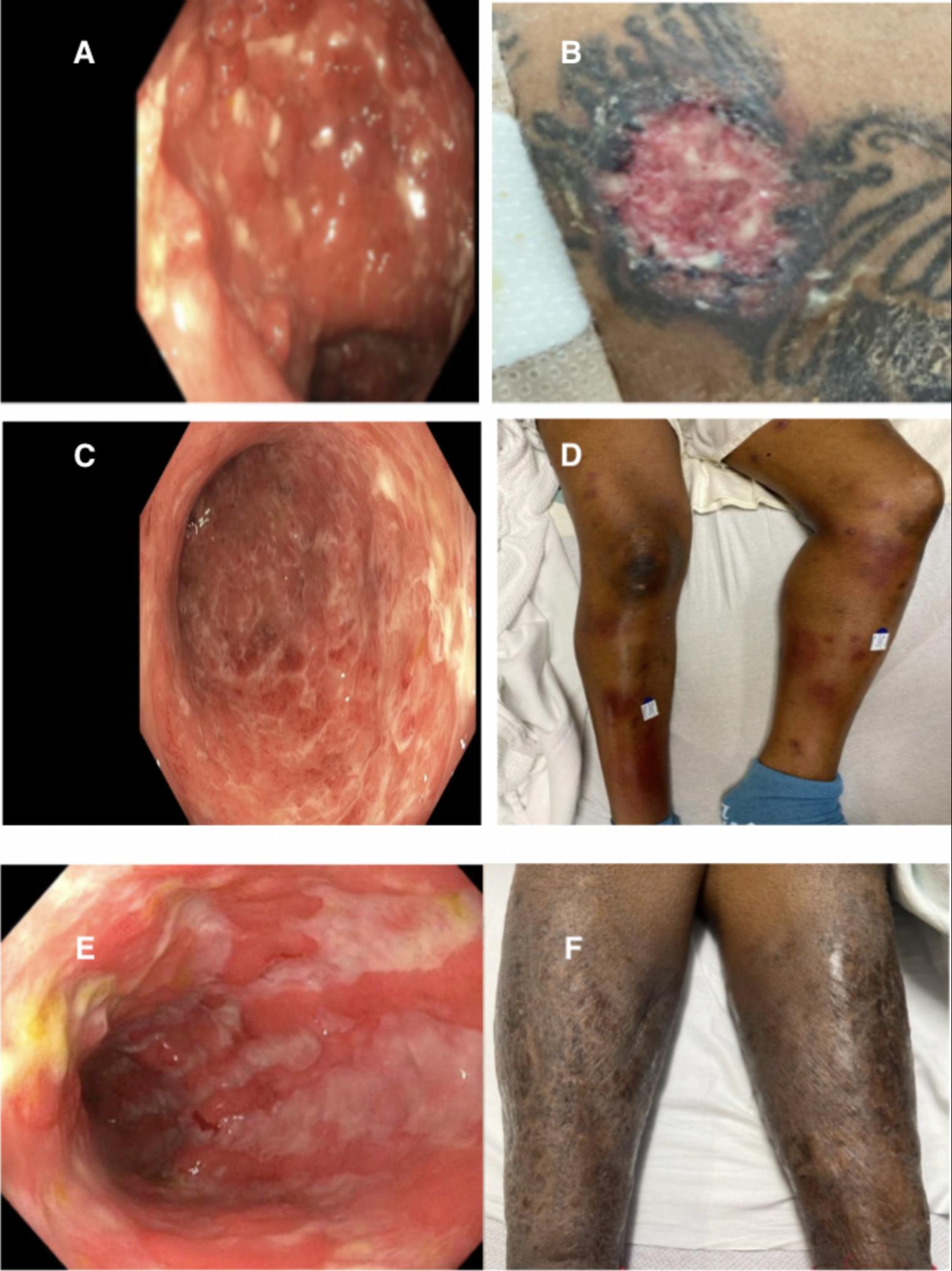Tuesday Poster Session
Category: IBD
P3649 - Hidden in Plain Sight: A Case Series of Inflammatory Bowel Disease With Dermatologic Lesions as Initial or Concurrent Manifestations
Tuesday, October 24, 2023
10:30 AM - 4:00 PM PT
Location: Exhibit Hall

Has Audio

Kinan Obeidat, MD
University of Texas Medical Branch
Galveston, TX
Presenting Author(s)
Kinan Obeidat, MD, Jordan Malone, DO, Hamza Salim, DO, Hwewon E. Lee, DO, Ernesto Zamora, MD, Sheharyar Merwat, MBBS
University of Texas Medical Branch, Galveston, TX
Introduction: Erythema nodosum (EN) and Pyoderma gangrenosum (PG) are rare cutaneous conditions with an incidence of only 1 to 5 cases per 100,000 persons and 3 to 10 cases per million people, respectively. EN is an acute nodular septal panniculitis while PG is a rare ulcerative, non-infectious neutrophilic dermatosis both commonly associated with inflammatory bowel disease (IBD). Here we present the cases of three patients, with no significant gastrointestinal past medical history, who presented to our institution with worsening cutaneous lesions as well as new-onset hematochezia.
Case Description/Methods: We present the cases of three patients with no significant past medical history who presented to our institution with worsening bloody diarrhea. All patients noted a standing history of cutaneous lesions without a formal diagnosis. One patient noted diffuse lesions of his lower extremities and head. Another noted a worsening right anterior shoulder lesion. The third patient had a standing history of diffuse cutaneous lesions since childhood that were responsive to topical steroids but were never formally diagnosed despite biopsy. Two of the three patients had dermatologic symptoms that coincided with the start of their gastrointestinal complaints. Biopsy results of the skin lesions were consistent with pyoderma gangrenosum in two of the three patients, and erythema nodosum in the third. All three patients underwent diagnostic colonoscopy with biopsies consistent with underlying IBD. All three patients had clinical improvement with initiation of steroids and subsequent biologic agents.
Discussion: The prevalence of extraintestinal manifestations (EIM) in patients with IBD ranges from 6-47% with a peak presentation at 90 months following diagnosis. PG and EN can be misdiagnosed and then mistreated with antibiotics, delaying the proper diagnosis of an underlying inflammatory disease and exposing patients to unnecessary antibiotics. These cases display the importance of a proper review of symptoms and further workup of dermatological lesions prior to assuming infectious etiology.

Disclosures:
Kinan Obeidat, MD, Jordan Malone, DO, Hamza Salim, DO, Hwewon E. Lee, DO, Ernesto Zamora, MD, Sheharyar Merwat, MBBS. P3649 - Hidden in Plain Sight: A Case Series of Inflammatory Bowel Disease With Dermatologic Lesions as Initial or Concurrent Manifestations, ACG 2023 Annual Scientific Meeting Abstracts. Vancouver, BC, Canada: American College of Gastroenterology.
University of Texas Medical Branch, Galveston, TX
Introduction: Erythema nodosum (EN) and Pyoderma gangrenosum (PG) are rare cutaneous conditions with an incidence of only 1 to 5 cases per 100,000 persons and 3 to 10 cases per million people, respectively. EN is an acute nodular septal panniculitis while PG is a rare ulcerative, non-infectious neutrophilic dermatosis both commonly associated with inflammatory bowel disease (IBD). Here we present the cases of three patients, with no significant gastrointestinal past medical history, who presented to our institution with worsening cutaneous lesions as well as new-onset hematochezia.
Case Description/Methods: We present the cases of three patients with no significant past medical history who presented to our institution with worsening bloody diarrhea. All patients noted a standing history of cutaneous lesions without a formal diagnosis. One patient noted diffuse lesions of his lower extremities and head. Another noted a worsening right anterior shoulder lesion. The third patient had a standing history of diffuse cutaneous lesions since childhood that were responsive to topical steroids but were never formally diagnosed despite biopsy. Two of the three patients had dermatologic symptoms that coincided with the start of their gastrointestinal complaints. Biopsy results of the skin lesions were consistent with pyoderma gangrenosum in two of the three patients, and erythema nodosum in the third. All three patients underwent diagnostic colonoscopy with biopsies consistent with underlying IBD. All three patients had clinical improvement with initiation of steroids and subsequent biologic agents.
Discussion: The prevalence of extraintestinal manifestations (EIM) in patients with IBD ranges from 6-47% with a peak presentation at 90 months following diagnosis. PG and EN can be misdiagnosed and then mistreated with antibiotics, delaying the proper diagnosis of an underlying inflammatory disease and exposing patients to unnecessary antibiotics. These cases display the importance of a proper review of symptoms and further workup of dermatological lesions prior to assuming infectious etiology.

Figure: A and B: Colonoscopic and cutaneous findings of case 1
C and D: Colonoscopic and cutaneous findings of case 2
E and F: colonoscopic and cutaneous findings of case 3
C and D: Colonoscopic and cutaneous findings of case 2
E and F: colonoscopic and cutaneous findings of case 3
Disclosures:
Kinan Obeidat indicated no relevant financial relationships.
Jordan Malone indicated no relevant financial relationships.
Hamza Salim indicated no relevant financial relationships.
Hwewon Lee indicated no relevant financial relationships.
Ernesto Zamora indicated no relevant financial relationships.
Sheharyar Merwat indicated no relevant financial relationships.
Kinan Obeidat, MD, Jordan Malone, DO, Hamza Salim, DO, Hwewon E. Lee, DO, Ernesto Zamora, MD, Sheharyar Merwat, MBBS. P3649 - Hidden in Plain Sight: A Case Series of Inflammatory Bowel Disease With Dermatologic Lesions as Initial or Concurrent Manifestations, ACG 2023 Annual Scientific Meeting Abstracts. Vancouver, BC, Canada: American College of Gastroenterology.
